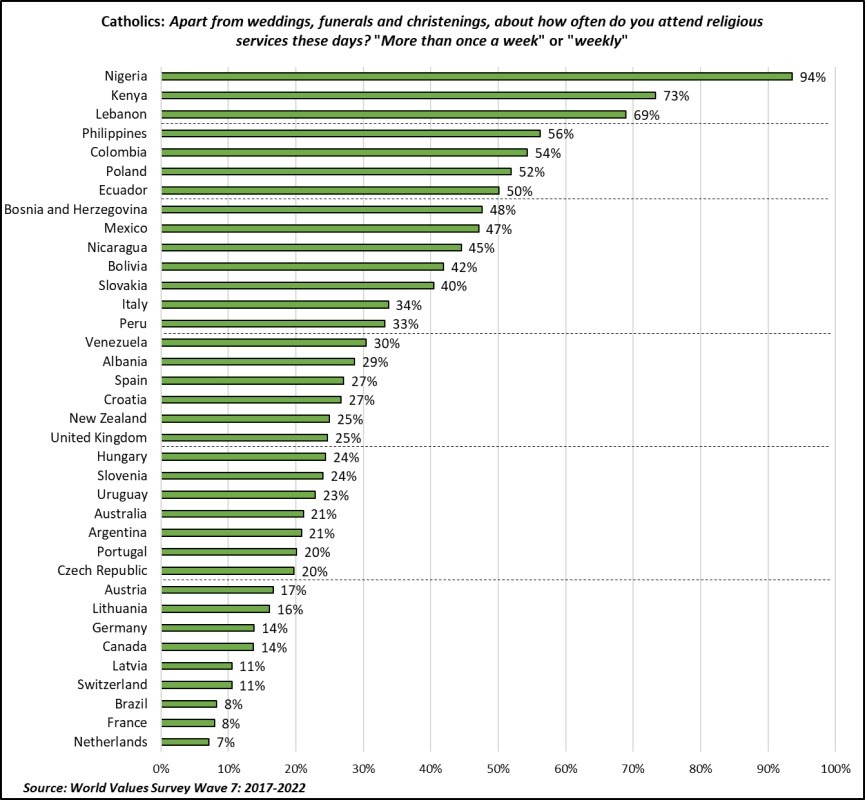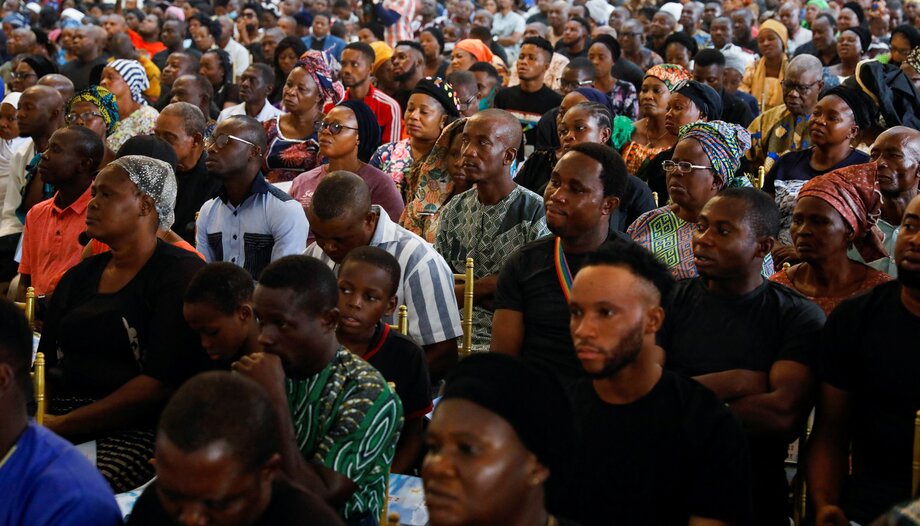Nigeria, Kenya and Lebanon top the list of countries with Catholics who attend Mass on Sundays or more frequently in the world. They are followed by the Philippines, Colombia, Poland and Ecuador, according to the World Values Survey (WVS), analyzed by the Center for Applied Research in the Apostolate (CARA), Georgetown University (USA).
Nigeria is the most populous country on the African continent, with 210 million inhabitants, of whom about 16 percent, 33 million, are Catholics. And in Kenya, with a population of 42.9 million people, Catholics represent 32.3 percent (approximately 16 million). Lebanon, the third in the ranking, has 6.67 million inhabitants, of whom 2.1 million are Catholics.
These are the countries that lead the ranking of Catholics who attend Mass on Sunday, or more frequently (in Nigeria, 94 %, in Kenya, 73 %, and in Lebanon, 69 %), says the World Values Survey (WVS) in its seventh wave (from the 1980s onwards), disseminated and analyzed by Nineteen Sixty fourresearch blog the CARA Research Center of Georgetownwith data from 36 countries with large Catholic populations.
The study does not include countries such as Democratic Republic of the CongoNeither Uganda, with 90 million inhabitants, more than half of whom are of the Christian faith, and which Pope Francis has just visited, nor Uganda, where Catholics account for 47 percent, more than 17 million, 47 percent of the country's 36.4 million inhabitants.
Group 2: Philippines, Colombia, Poland, Ecuador...
The next group of countries, where half or more of Catholics (50 % or more) attend weekly Eucharist, includes the Philippines (56 %), Colombia (54 %), Poland (52 %) and Ecuador (50 %).
Now comes a block in which we find Italy, for example, and in which less than half, but a third or more, attend Mass every week. They are Bosnia and Herzegovina (48 %), Mexico (47 %), Nicaragua (45 %), Bolivia (42 %), Slovakia (40 %), Italy (34 %) and Peru (33 %).
Between three in ten and a quarter of Catholics attend Mass each week in Venezuela (30 %), Albania (29 %), Spain (27 %), Croatia (27 %), New Zealand (25 %) and the United Kingdom (25 %).
In the CARA and WVS survey, approximately 24 % of Catholics in the United States attended Mass every week or more frequently prior to the Covid-19 pandemic in 2019.
In the most recent survey by the same agencies, 17 % of U.S. Catholic adults reported attending Mass with this frequency, with 5 % watching Mass online or on TV from home.
Other countries with Catholic Mass attendance similar to the United States are Hungary (24 %), Slovenia (24 %), Uruguay (23 %), Australia (21 %), Argentina (21 %), Portugal (20 %), the Czech Republic (201 %) and Austria (17 %).
The lowest levels of weekly attendance are observed, according to this work, in Lithuania (16 %), Germany (14 %), Canada (14 %), Latvia (11 %), Switzerland (11 %), Brazil (8 %), France (8 %) and the Netherlands (7 %).
People who consider themselves religious
One might assume, the report notes, that the more religious Catholics there are in a country, the more likely they are to attend Mass frequently. However, there is no strong correlation between the numbers of those who identify themselves as 'religious' Catholics and frequent Mass attendance. Specifically, the WVS survey asked respondents, "Regardless of whether you go to church or not, would you say you are...: a religious person, not a religious person, atheist or don't know."
There are countries where there is a close relationship between the answers to both questions, including the Netherlands, Argentina, Ecuador, the Philippines, Kenya and Nigeria.
But in many other countries this is not so. Lebanon, for example, has very high Mass attendance, comparatively speaking, but the proportion of Catholics there who consider themselves religious is substantially lower compared to other countries. Ninety-seven percent of Catholics in Uruguay consider themselves a religious person, yet only 23 % of Catholics attend Mass weekly or more frequently.
In addition to Uruguay, the countries where Catholics "are most likely to consider themselves religious," the study notes, are Nigeria (95 %), Albania (94 %), Slovakia (93 %), Czech Republic (92 %), Italy (92 %), Lithuania (92 %), Kenya (92 %), Colombia (92 %), Bolivia (91 %) and Poland (90 %).
More than three-quarters, but less than nine out of ten Catholics, consider themselves religious persons in these countries: Croatia (88 %), Bosnia and Herzegovina (88 %), Slovenia (87 %), Hungary (86 %), Portugal (85 %), Latvia (85 %), Peru (84 %), Philippines (83 %), Ecuador (82 %), Brazil (82 %), Argentina (79 %), Netherlands (78 %), Mexico (77 %) and Nicaragua (76 %).
Catholics in the United States are behind this group with 74 % considering themselves a religious person. The United States is followed by France (72 %), Austria (69 %), Australia (67 %), Spain (67 %), Germany (65 %), Switzerland (63 %), Lebanon (62 %), United Kingdom, (59 %), Venezuela (57%), Canada (55%) and New Zealand (55%).
It is interesting to note, according to the report, that in terms of identification as a religious person, Catholics in the United States and France are quite similar (74 % and 72 %, respectively). However, only 8 % of Catholics in France attend Mass weekly compared to 17 % of Catholics in the United States (and 24 % attended weekly before the pandemic).
The economic factor
There is a third factor that the report confronts and that is GDP (Gross Domestic Product, national wealth) per capita. Mass attendance drops sharply as GDP per capita increases to $10,000, and then this drop slows and flattens out as GDP per capita continues to increase.
Religiosity has a more linear, albeit weaker, relationship with GDP per capita. There is a large group of countries with a GDP per capita of less than $25,000 that have one of the highest proportions of Catholics who self-identify as religious.
"In higher-income countries, religiosity falls," CARA and WVS note. Switzerland, with the highest GDP per capita of the countries surveyed, has low levels of weekly Mass attendance and relatively fewer Catholics who self-identify as religious.
In this small sample of countries, the report states that "we can assume that Catholicism is strongest in what is often called the developing world, where GDP per capita is lowest, while it appears to be contracting in the wealthier 'developed' countries. The precise mechanisms associated with economic development and wealth that are affecting Catholics' faith participation and identification as religious are unclear. Whatever they are, they matter significantly," the paper concludes.









